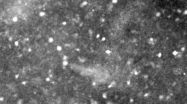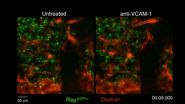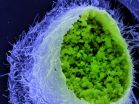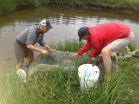Spiral laser beam creates quantum whirlpool
Physicists have engineered a spiral laser beam and used it to create a whirlpool of hybrid light-matter particles called polaritons, hybrid particles that have properties of both matter and light and could link electronics with photonics
2014-11-17
(Press-News.org) Physicists have engineered a spiral laser beam and used it to create a whirlpool of hybrid light-matter particles called polaritons.
"Creating circulating currents of polaritons - vortices - and controlling them has been a long-standing challenge," said leader of the team, theoretician Dr Elena Ostrovskaya, from the Research School of Physics and Engineering at The Australian National University (ANU).
"We can now create a circulating flow of these hybrid particles and sustain it for hours."
Polaritons are hybrid particles that have properties of both matter and light. The ability to control polariton flows in this way could aid the development of completely novel technology to link conventional electronics with new laser and fibre-based technologies.
Polaritons form in semiconductors when laser light interacts with electrons and holes (positively charged vacancies) so strongly that it is no longer possible to distinguish light from matter.
The team created the spiral beam by putting their laser through a piece of brass with a spiral pattern of holes in it. This was directed into a semiconductor microcavity, a tiny wafer of aluminium gallium arsenide, a material used in LEDs, sandwiched between two reflectors.
"The vortices have previously only appeared randomly, and always in pairs that swirl in opposite directions," said Dr Robert Dall, who led the experimental part of the project.
"However, by using a spiral mask to structure our laser, we create a chiral system that prefers one flow direction. Therefore we can create a single, stable vortex at will."
These vortices are an example of quantum fluid behaviour in which the polaritons coalesce into a rare state of matter known as a Bose-Einstein condensate.
"As well as being a window into the quantum world, these polaritonic vortices could be used to construct extremely sensitive detectors of electromagnetic fields, similar to SQUIDS (Superconducting QUantum Interference Devices)," Dr Ostrovskaya said.
"They could also be employed as quantum information carriers."
The ANU team has pioneered the study of microcavity polaritons in Australia and hope their success will inspire other research groups around the country.
"Polaritonics is a rapidly developing research field all around the world. We hope we can build a network of groups researching these devices across Australia and joining the international effort," Dr Ostrovskaya said.
INFORMATION:
[Attachments] See images for this press release:
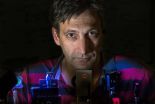

ELSE PRESS RELEASES FROM THIS DATE:
2014-11-17
CHICAGO and BOSTON - Nov. 16, 2014 - The Harvard Clinical Research Institute (HCRI) announced today results of the DAPT Study, a major international study that investigated the duration of dual antiplatelet therapy (DAPT, the combination of aspirin and a thienopyridine/antiplatelet medication to reduce the risk of blood clots) following coronary stent implantation. The continuation of dual antiplatelet therapy beyond one year resulted in significant benefits compared with aspirin alone, including reducing the rare but serious problem of stent thrombosis and preventing heart ...
2014-11-17
Leading coral reef scientists in Australia and the USA say there needs to be a new approach to protecting the future of marine ecosystems, with a shift away from the current focus on extinction threat.
"Extinction is the final endpoint, but coral reefs are in deep trouble long before we get to that point. We need to take action much earlier," says Professor David Bellwood from the ARC Centre of Excellence for Coral Reef Studies (Coral CoE) at James Cook University.
"The goal should be to maintain reefs that can support corals, fish and humans" Professor Bellwood says.
In ...
2014-11-17
VIDEO:
The neurons in this video contain a dye that fluoresces when it encounters calcium ions. When the neuron is excited, calcium floods into the cell and the neuron fluoresces. The...
Click here for more information.
Synapse, the name for the signal-receiving site on a neuron, comes from the Greek word for contact. Neuroscientists used to maintain that neurons form one-to-one relationship to contact one another. Yet more researchers are finding evidence that shows how neurons ...
2014-11-17
VIDEO:
The movement of bone marrow B cells was limited in the absence of VCAM-1, as shown in this time-lapse video. B cells (green) were tracked before (left) and after (right)...
Click here for more information.
Newly formed B cells take the easy way out when it comes to exiting the bone marrow, according to a study published in The Journal of Experimental Medicine.
For infection-fighting T and B cells to defend the body, they must first leave their birthplace--the thymus for ...
2014-11-17
This news release is available in German.
Infections due to the sexually transmitted bacterium Chlamydia trachomatis often remain unnoticed. The pathogen is not only a common cause of female infertility; it is also suspected of increasing the risk of abdominal cancer. A research team at the Max Planck Institute for Infection Biology in Berlin has now observed the breakdown of an important endogenous protective factor in the course of chlamydial infection. By activating the destruction of p53 protein, the bacterium blocks a key protective mechanism of infected cells, ...
2014-11-17
Doctors tell us that the frenzied pace of the modern 24-hour lifestyle -- in which we struggle to juggle work commitments with the demands of family and daily life -- is damaging to our health. But while life in the slow lane may be better, will it be any longer? It will if you're a reptile.
A new study by Tel Aviv University researchers finds that reduced reproductive rates and a plant-rich diet increases the lifespan of reptiles. The research, published in the journal Global Ecology and Biogeography, was led by Prof. Shai Meiri, Dr. Inon Scharf, and doctoral student ...
2014-11-17
If you want to see into the future, you have to understand the past. An international consortium of researchers under the auspices of the University of Bonn has drilled deposits on the bed of Lake Van (Eastern Turkey) which provide unique insights into the last 600,000 years. The samples reveal that the climate has done its fair share of mischief-making in the past. Furthermore, there have been numerous earthquakes and volcanic eruptions. The results of the drilling project also provide a basis for assessing the risk of how dangerous natural hazards are for today's population. ...
2014-11-17
WASHINGTON, D.C. - Two or more serious hits to the head within days of each other can interfere with the brain's ability to use sugar - its primary energy source - to repair cells damaged by the injuries, new research suggests.
The brain's ability to use energy is critical after an injury. In animal studies, Ohio State University scientists have shown that brain cells ramp up their energy use six days after a concussion to recover from the damage. If a second injury occurs before that surge of energy use starts, the brain loses its best chance to recover.
In mice, ...
2014-11-17
Mikhail Kosiborod, M.D., of Saint Luke's Mid America Heart Institute, Kansas City, and colleagues evaluated the efficacy and safety of the drug zirconium cyclosilicate in patients with hyperkalemia (higher than normal potassium levels). The study appears in JAMA and is being released to coincide with its presentation at the American Heart Association's Scientific Sessions 2014.
Hyperkalemia is a common electrolyte disorder which can cause potentially life-threatening cardiac arrhythmias and is associated with chronic kidney disease, heart failure, and diabetes mellitus. ...
2014-11-17
BLOOMINGTON, Ind. -- An Indiana University-Dartmouth College team has identified genes and regulatory patterns that allow some organisms to alter their body form in response to environmental change.
Understanding how an organism adopts a new function to thrive in a changing environment has implications for molecular evolution and many areas of science including climate change and medicine, especially in regeneration and wound healing.
The study, which appears in the journal Molecular Biology and Evolution, provides insight into phenotypic plasticity, a phenomenon that ...
LAST 30 PRESS RELEASES:
[Press-News.org] Spiral laser beam creates quantum whirlpool
Physicists have engineered a spiral laser beam and used it to create a whirlpool of hybrid light-matter particles called polaritons, hybrid particles that have properties of both matter and light and could link electronics with photonics




